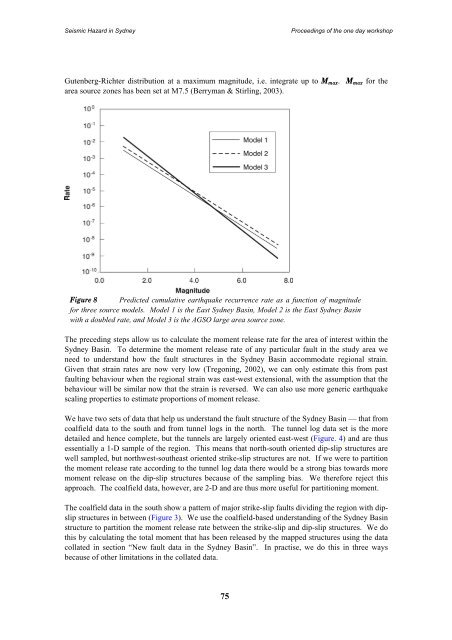Landslides in the Sydney Basin - Geoscience Australia
Landslides in the Sydney Basin - Geoscience Australia
Landslides in the Sydney Basin - Geoscience Australia
- No tags were found...
Create successful ePaper yourself
Turn your PDF publications into a flip-book with our unique Google optimized e-Paper software.
Seismic Hazard <strong>in</strong> <strong>Sydney</strong>Proceed<strong>in</strong>gs of <strong>the</strong> one day workshopGutenberg-Richter distribution at a maximum magnitude, i.e. <strong>in</strong>tegrate up to M max . M max for <strong>the</strong>area source zones has been set at M7.5 (Berryman & Stirl<strong>in</strong>g, 2003).Figure 8 Predicted cumulative earthquake recurrence rate as a function of magnitudefor three source models. Model 1 is <strong>the</strong> East <strong>Sydney</strong> Bas<strong>in</strong>, Model 2 is <strong>the</strong> East <strong>Sydney</strong> Bas<strong>in</strong>with a doubled rate, and Model 3 is <strong>the</strong> AGSO large area source zone.The preced<strong>in</strong>g steps allow us to calculate <strong>the</strong> moment release rate for <strong>the</strong> area of <strong>in</strong>terest with<strong>in</strong> <strong>the</strong><strong>Sydney</strong> Bas<strong>in</strong>. To determ<strong>in</strong>e <strong>the</strong> moment release rate of any particular fault <strong>in</strong> <strong>the</strong> study area weneed to understand how <strong>the</strong> fault structures <strong>in</strong> <strong>the</strong> <strong>Sydney</strong> Bas<strong>in</strong> accommodate regional stra<strong>in</strong>.Given that stra<strong>in</strong> rates are now very low (Tregon<strong>in</strong>g, 2002), we can only estimate this from pastfault<strong>in</strong>g behaviour when <strong>the</strong> regional stra<strong>in</strong> was east-west extensional, with <strong>the</strong> assumption that <strong>the</strong>behaviour will be similar now that <strong>the</strong> stra<strong>in</strong> is reversed. We can also use more generic earthquakescal<strong>in</strong>g properties to estimate proportions of moment release.We have two sets of data that help us understand <strong>the</strong> fault structure of <strong>the</strong> <strong>Sydney</strong> Bas<strong>in</strong> — that fromcoalfield data to <strong>the</strong> south and from tunnel logs <strong>in</strong> <strong>the</strong> north. The tunnel log data set is <strong>the</strong> moredetailed and hence complete, but <strong>the</strong> tunnels are largely oriented east-west (Figure. 4) and are thusessentially a 1-D sample of <strong>the</strong> region. This means that north-south oriented dip-slip structures arewell sampled, but northwest-sou<strong>the</strong>ast oriented strike-slip structures are not. If we were to partition<strong>the</strong> moment release rate accord<strong>in</strong>g to <strong>the</strong> tunnel log data <strong>the</strong>re would be a strong bias towards moremoment release on <strong>the</strong> dip-slip structures because of <strong>the</strong> sampl<strong>in</strong>g bias. We <strong>the</strong>refore reject thisapproach. The coalfield data, however, are 2-D and are thus more useful for partition<strong>in</strong>g moment.The coalfield data <strong>in</strong> <strong>the</strong> south show a pattern of major strike-slip faults divid<strong>in</strong>g <strong>the</strong> region with dipslipstructures <strong>in</strong> between (Figure 3). We use <strong>the</strong> coalfield-based understand<strong>in</strong>g of <strong>the</strong> <strong>Sydney</strong> Bas<strong>in</strong>structure to partition <strong>the</strong> moment release rate between <strong>the</strong> strike-slip and dip-slip structures. We dothis by calculat<strong>in</strong>g <strong>the</strong> total moment that has been released by <strong>the</strong> mapped structures us<strong>in</strong>g <strong>the</strong> datacollated <strong>in</strong> section “New fault data <strong>in</strong> <strong>the</strong> <strong>Sydney</strong> Bas<strong>in</strong>”. In practise, we do this <strong>in</strong> three waysbecause of o<strong>the</strong>r limitations <strong>in</strong> <strong>the</strong> collated data.
















